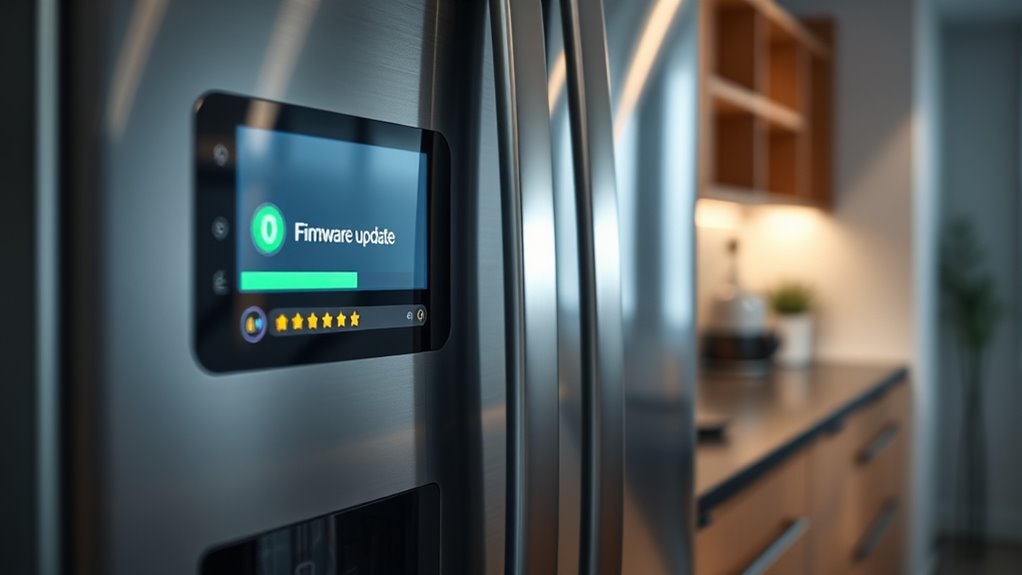To keep your appliances secure, enabling OTA firmware updates is essential. These updates allow you to install security patches, bug fixes, and new features remotely, reducing vulnerability and improving performance. Using automatic updates and secure networks guarantees your devices stay current and protected from threats. Regularly verifying firmware versions and following best practices helps prevent security breaches and device malfunctions. Exploring more will give you practical tips to enhance your appliance security effectively.
Key Takeaways
- Regular OTA updates patch security vulnerabilities, preventing exploitation and ensuring appliances remain protected from emerging threats.
- Use secure encryption protocols to safeguard firmware transmission and verify updates from official sources.
- Enable automatic updates to ensure devices receive critical patches promptly without manual intervention.
- Implement rollback options and version control to maintain firmware integrity and recover from failed updates.
- Schedule routine firmware checks and connect appliances to secure networks with strong encryption like WPA3 or WPA2.
Understanding OTA Firmware Updates
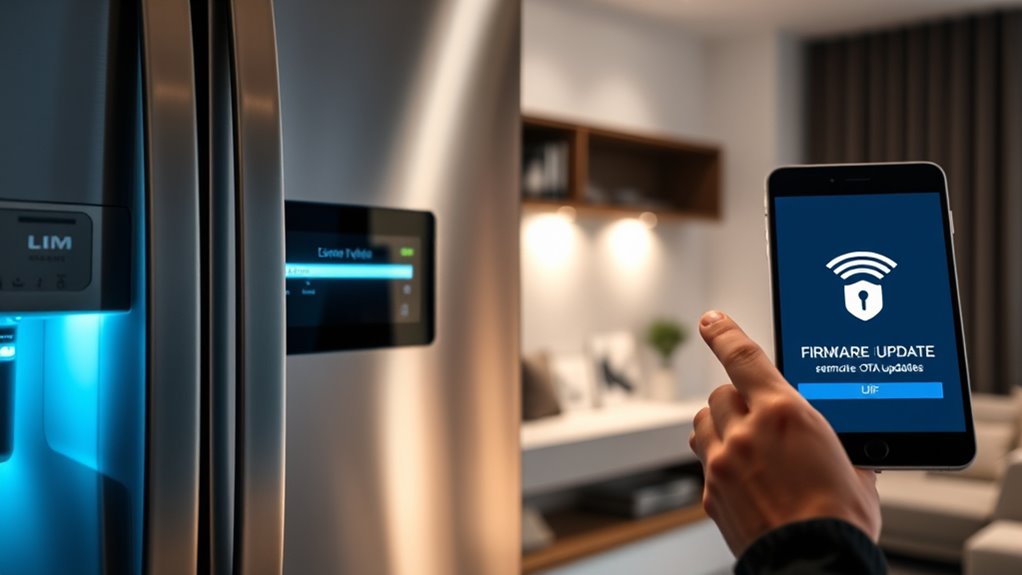
OTA firmware updates, or Over-The-Air updates, allow your devices to receive software improvements without the need for manual intervention or connecting to a computer. Instead, the update process happens wirelessly, often in the background, making it seamless for you. When an update is available, your device typically notifies you, and you can choose to install it immediately or later. These updates usually include security patches, bug fixes, performance enhancements, and new features, helping your device stay current and secure. OTA updates are designed to be quick and efficient, minimizing downtime. They rely on internet connectivity and remote servers to deliver the latest software. This process simplifies maintenance, ensuring your device remains up-to-date without requiring technical skills or additional hardware.
The Benefits of Remote Firmware Management
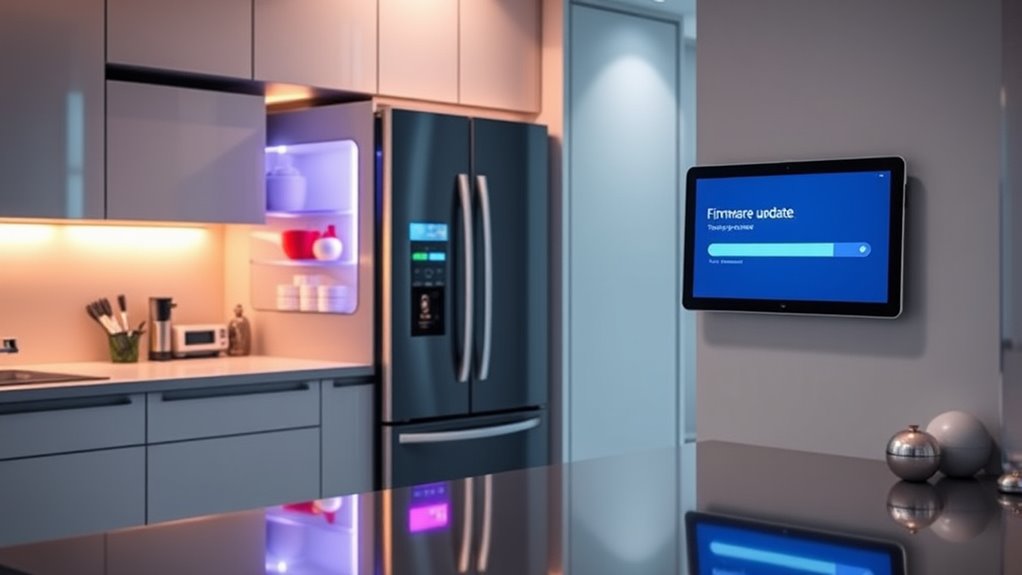
Remote firmware management streamlines device maintenance by allowing updates and troubleshooting to be performed without physical access. This means you can quickly fix issues, improve performance, and add new features from anywhere, saving you time and effort. It reduces the need for service calls, minimizing downtime and inconvenience. Additionally, remote management enables you to schedule updates during off-peak hours, avoiding disruptions during critical usage times. You also gain real-time insights into device health, helping you identify potential problems early. This proactive approach enhances overall appliance reliability and longevity. Effective wall organization can also be integrated with smart home systems for enhanced control and monitoring. With remote firmware management, you maintain better control over your devices, ensuring they stay current, secure, and functioning best without the need for physical intervention. Proper management also helps prevent software vulnerabilities that could compromise appliance security, especially when paired with regular security updates. Understanding cybersecurity risks associated with connected devices further underscores the importance of consistent updates to protect against potential threats. Regular firmware updates are essential because they often include patches for known security flaws, reducing the chances of cyberattacks targeting your appliances.
How OTA Updates Enhance Appliance Security
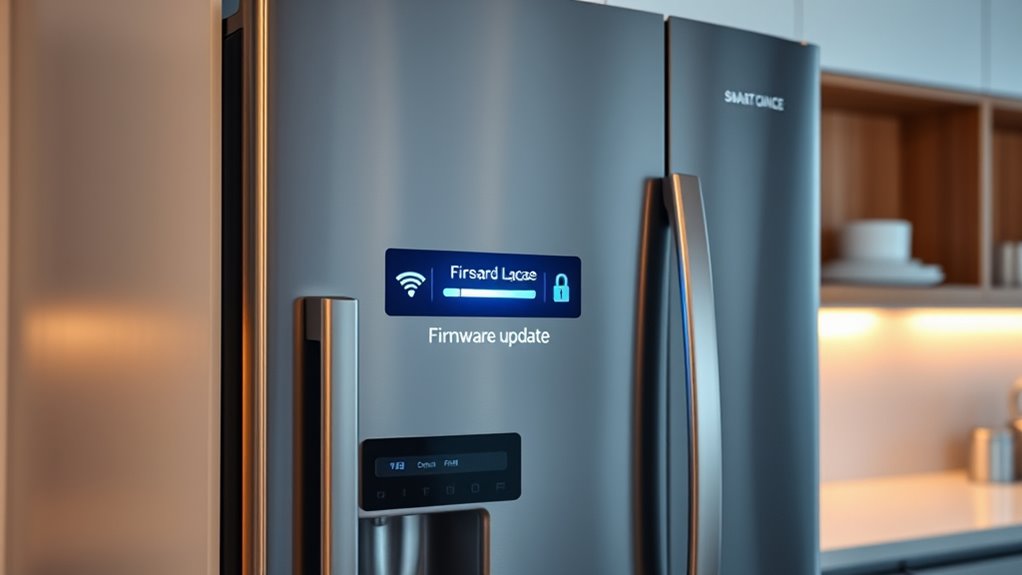
Regular firmware updates delivered over-the-air play a crucial role in safeguarding your appliances against security vulnerabilities. They patch known weaknesses, closing security gaps before hackers can exploit them. When updates are automatic, you don’t need to worry about manually checking for patches or missing critical fixes. This keeps your appliances protected in real-time, reducing the risk of data breaches or malicious attacks. OTA updates also enable manufacturers to quickly respond to emerging threats by deploying security patches swiftly. This proactive approach ensures your devices stay resilient against evolving cyber threats. Regular firmware updates also help detect and fix spoiled juice or other security issues early on, maintaining the integrity of your appliances and giving you peace of mind that your smart home remains secure and protected against potential vulnerabilities. Additionally, these updates facilitate compliance with security standards, ensuring that your devices adhere to the latest security protocols and regulations. Incorporating continuous security monitoring can further enhance the detection and prevention of emerging cyber threats, making your smart home environment even safer. Furthermore, timely updates can prevent hardware malfunctions caused by outdated firmware, extending the lifespan of your appliances and maintaining optimal performance.
The Technology Behind Seamless Updates
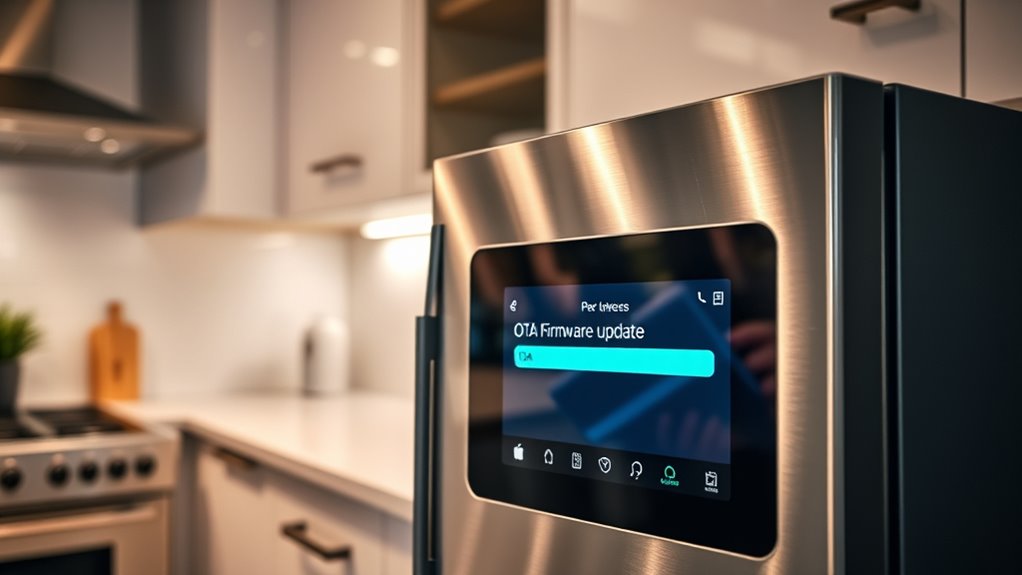
Seamless updates rely on a combination of advanced technologies that guarantee your appliances stay current without disrupting their operation. One key technology is delta updates, which only download the changes rather than the entire firmware, saving time and bandwidth. Secure encryption protocols ensure that updates are transmitted safely, preventing tampering or interception. Over-the-air delivery uses reliable communication channels like Wi-Fi or cellular networks, enabling updates to happen automatically or at scheduled times. Version control systems verify that your device receives the correct update and prevent incompatible software from installing. Additionally, robust rollback mechanisms allow your appliance to revert to a previous firmware version if an update fails, ensuring continuous operation. Proper update management is essential for maintaining the security and functionality of your appliances over time. Incorporating a comprehensive testing process helps to identify potential issues before updates are rolled out broadly. This process should also include monitoring tools to detect any anomalies post-update, further enhancing security. Continuous advancements in update technology contribute to more reliable and efficient firmware management, ensuring your appliances remain secure and functional for years to come. Together, these technologies create a smooth, secure update process that keeps your appliances reliable and up-to-date.
Common Challenges and How to Overcome Them
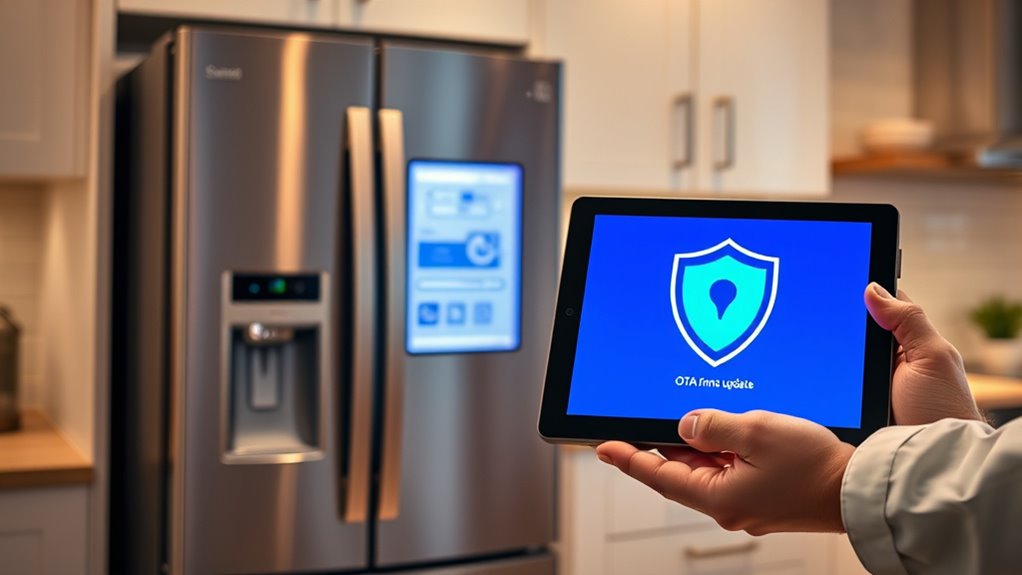
Despite the advancements in OTA firmware updates, several common challenges can hinder their effectiveness. One major issue is interrupted updates, which can corrupt firmware and brick devices. To avoid this, guarantee reliable internet connections and implement rollback options. Compatibility problems also arise when updates don’t match device models or hardware versions, so thorough testing before deployment is essential. Security concerns, like potential interception or tampering, require strong encryption and authentication protocols. Additionally, users may delay updates due to inconvenience or lack of awareness, leaving appliances vulnerable. To overcome these hurdles, automate updates where possible, communicate clearly about their importance, and enforce security best practices. Furthermore, ensuring that firmware updates are compatible with vetted device models helps maintain device integrity and performance. Regular firmware monitoring and prompt responses to identified issues can further enhance device security and reliability. Staying informed about security protocols and implementing them properly can significantly reduce the risk of malicious attacks. Incorporating industry standards can also guide the development of more secure and effective update processes. Addressing these challenges ensures your appliances stay protected and perform at their best. In addition, fostering a culture of proactive maintenance among users can greatly reduce the likelihood of vulnerabilities and improve overall device longevity.
Best Practices for Regular Firmware Maintenance
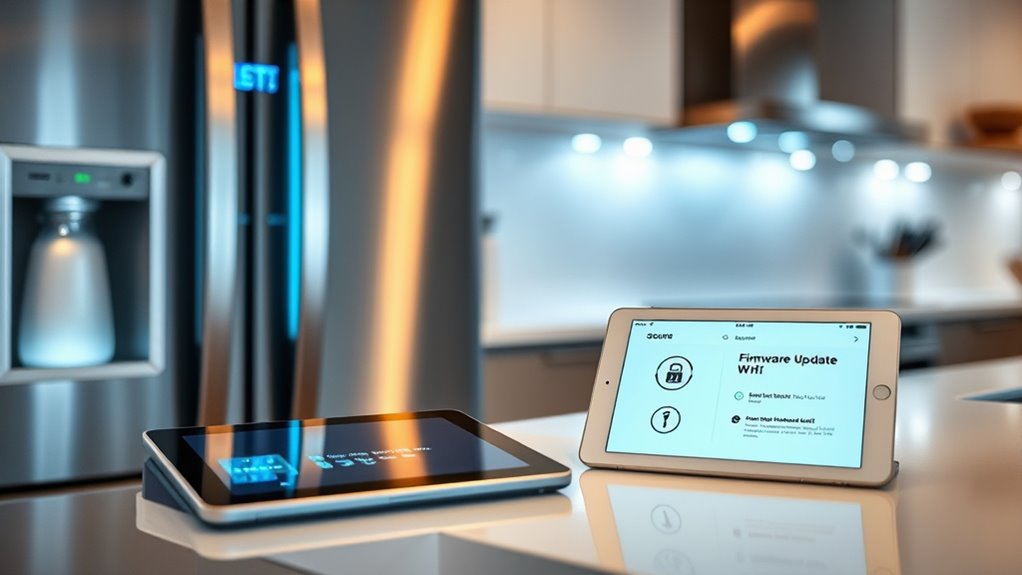
To keep your devices secure and running smoothly, you should regularly schedule firmware checks. It’s also essential to verify that your update sources are trustworthy before applying any updates. Following these best practices helps prevent potential issues and guarantees reliable maintenance.
Schedule Firmware Checks
Scheduling regular firmware checks is essential for maintaining device security and performance. By setting up a routine, you ensure your appliances stay up-to-date with the latest security patches and feature enhancements. Determine a check frequency based on device usage and manufacturer recommendations—monthly or quarterly checks often suffice. Use a structured approach, such as a table, to track firmware status and update history:
| Device Type | Check Frequency | Last Check Date | Next Scheduled Check |
|---|---|---|---|
| Smart Thermostat | Monthly | 2024-04-01 | 2024-05-01 |
| Security Cameras | Quarterly | 2024-03-15 | 2024-06-15 |
| Smart Locks | Monthly | 2024-04-10 | 2024-05-10 |
| Appliances | Quarterly | 2024-03-20 | 2024-06-20 |
Consistent checks minimize vulnerabilities and ensure your devices operate smoothly.
Verify Update Sources
Ensuring you’re updating your devices from legitimate sources is vital for maintaining security and performance. Always download firmware updates directly from official manufacturer websites or trusted app stores. Avoid third-party links or unofficial repositories, as they may host compromised or tampered files that can introduce malware or cause device malfunctions. Before installing an update, verify the source’s authenticity by checking digital signatures or certificates provided by the manufacturer. Be cautious of emails or notifications prompting updates; confirm they are legitimate before acting. Regularly review your device’s update notifications and only accept updates from verified sources. This practice helps prevent security breaches, guarantees compatibility, and keeps your appliances running smoothly. Staying vigilant about update sources is a simple but essential step in secure firmware management.
Future Trends in Appliance Connectivity and Security
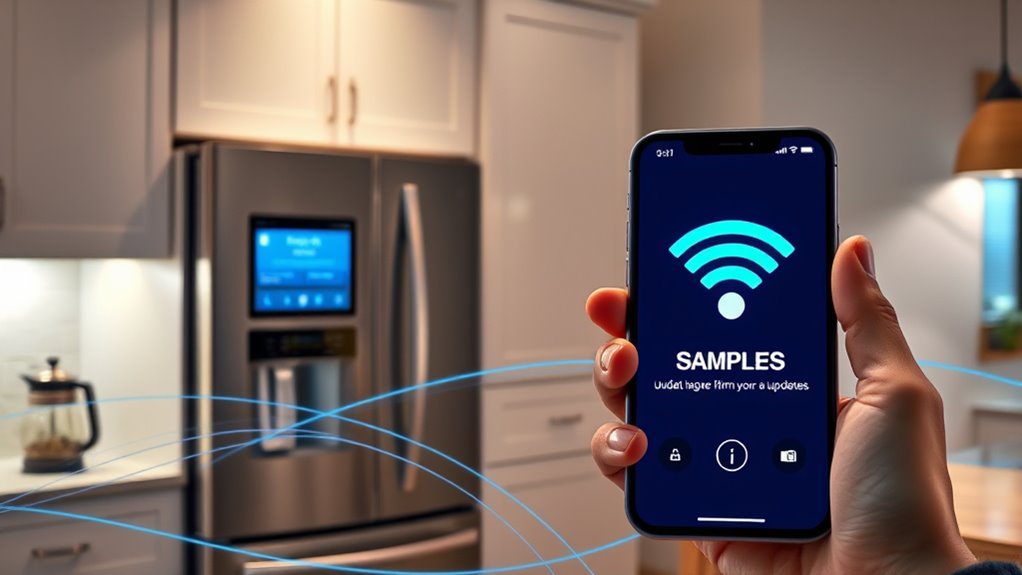
As appliance connectivity continues to expand, security concerns become increasingly critical. Future trends will likely include more sophisticated encryption methods to protect data and prevent unauthorized access. You’ll see greater adoption of AI-driven security systems that can detect and respond to threats in real-time. Manufacturers may implement blockchain technology to ensure firmware integrity and traceability. Additionally, you’ll notice more appliances designed with built-in hardware security modules for enhanced protection. As standards evolve, expect increased collaboration across industry players to establish unified security protocols. The goal is to create a safer ecosystem where your connected appliances operate seamlessly without exposing your personal information or home to cyber threats. Staying aware of these trends helps you appreciate ongoing efforts to keep your smart home secure.
Tips for Users to Stay Protected With Firmware Updates

To stay protected with firmware updates, you should enable automatic updates whenever possible so your devices stay current. Always use secure networks when updating to prevent potential hacking attempts. Additionally, make it a habit to regularly check your firmware versions to make certain your devices are running the latest, safest software.
Enable Automatic Updates
Have you considered enabling automatic firmware updates? Turning on this feature guarantees your devices stay current without manual intervention. Automatic updates provide critical security patches and performance improvements as soon as they’re available, reducing the risk of vulnerabilities. It’s a simple way to keep your appliances protected from new threats, especially since manufacturers often release updates silently. By enabling this option, you won’t forget to check for updates or delay installing them. Most devices allow you to activate automatic updates in settings or app preferences. Just make sure your device is connected to a reliable internet connection. This proactive step minimizes your effort while maximizing security, giving you peace of mind knowing your appliances are always running the latest, most secure firmware.
Use Secure Networks
Using secure networks is essential when updating your firmware, as unprotected connections can expose your devices to hackers and data breaches. Always connect to trusted Wi-Fi networks, avoiding public or open networks that lack encryption. Before starting an update, verify that your network uses WPA3 or WPA2 encryption, which helps protect your data during transmission. Consider using a virtual private network (VPN) to add an extra layer of security, especially if you’re on a network you don’t fully trust. Keep your router’s firmware updated to prevent vulnerabilities, and disable automatic connections to unfamiliar networks. By taking these precautions, you reduce the risk of interception or tampering during firmware updates, ensuring your appliances stay secure and your personal information remains protected.
Regularly Check Firmware
Regularly verifying your device’s firmware guarantees you stay protected against the latest security vulnerabilities. Check for updates frequently by visiting your device’s settings or manufacturer’s website. Staying proactive helps patch weaknesses before hackers exploit them. Schedule regular checks or enable automatic updates if available. Keep in mind that firmware updates often bring security improvements and new features. To stay organized, consider tracking your devices and their firmware versions. Here’s a quick reference:
| Device Type | Check Frequency | Update Method |
|---|---|---|
| Smart TV | Monthly | Automatic or Manual |
| Router | Bi-weekly | Manual |
| IoT Devices | Weekly | Automatic or Manual |
| Smartphones | Weekly | Automatic or Manual |
| Appliances | Monthly | Manufacturer’s App/Website |
Regular checks guarantee your devices remain secure and functional.
Frequently Asked Questions
How Often Should Firmware Updates Be Checked for on Appliances?
You should check your appliance firmware updates regularly to guarantee security and peak performance. Ideally, do this once a month or whenever the manufacturer releases new updates. Many devices can automatically notify you or update themselves, but it’s smart to verify manually. Staying proactive helps prevent vulnerabilities, keeps your appliances running smoothly, and protects your personal data from potential cyber threats. Regular updates are a simple but vital part of appliance maintenance.
Can Firmware Updates Improve Appliance Performance Besides Security?
Firmware updates do more than just boost security; they can also improve your appliance’s performance. When you keep your devices updated, you might notice faster operation, new features, or better energy efficiency. Manufacturers release these updates to fix bugs and enhance functionality. So, by regularly checking for firmware updates, you guarantee your appliances run smoothly, stay up-to-date, and provide the best user experience possible.
Are There Risks Involved in Automatic OTA Firmware Updates?
Isn’t it true that change always carries some risk? Automatic OTA firmware updates can sometimes cause issues like bugs or compatibility problems, which might disrupt your appliance’s function. While they’re designed to improve security and performance, you could face unexpected glitches or downtime. To minimize risks, verify your device has reliable update controls and stays connected to a trusted network. Staying informed helps you enjoy the benefits without unnecessary worry.
How Do Manufacturers Ensure the Authenticity of Firmware Updates?
You might wonder how manufacturers guarantee firmware updates are genuine. They use digital signatures and cryptographic verification methods to confirm the authenticity of updates. When you receive an update, your device checks these signatures against trusted keys stored securely. If the verification passes, the update installs; if not, it’s rejected. This process prevents malicious or tampered firmware from compromising your appliance’s security and functionality.
What Should Users Do if an Update Causes Appliance Malfunctions?
Think of your appliance as a car; sometimes, a new software update is like a sudden detour. If it causes malfunctions, first, try restarting the device; often, that clears minor glitches. If issues persist, consult the user manual or contact customer support. Remember, just like a detour, sometimes the fix requires patience and guidance to get back on the right track. Don’t ignore problems—address them promptly to protect your device.
Conclusion
Staying on top of OTA firmware updates keeps your appliances secure and running smoothly. Regular updates close security gaps and improve functionality, but are you taking full advantage of these benefits? Imagine your smart home as a fortress, constantly reinforced with the latest defenses. By staying proactive and informed, you protect your devices—and yourself—from potential threats. Don’t wait until it’s too late—are you ready to keep your appliances secure with timely updates?
